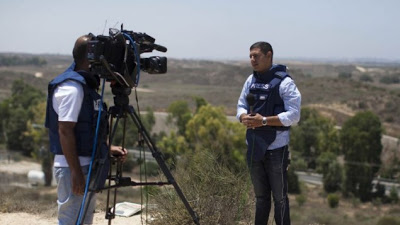
 |
| Reporting from the Israeli side of the border with Hamas-controlled Gaza [Image Source] |
It’s the coldest part of winter in our part of the world, and there have been serious interruptions to the electricity supply in the Gaza Strip. The Islamist thugs who rule the enclave have responded in traditional fashion. And yes, personal violence is of course central to the story.
“Hamas forces blocked journalists from filming the gathering, and an Associated Press journalist was briefly detained at gunpoint until he handed over his mobile phones to plainclothes security men…” [Associated Press item reported last Friday]
Our attention was drawn to this via a piece that appeared Thursday on the website of TheTower.org [here] which says operatives of Hamas
blocked journalists from filming a major protest against power cuts in the northern Gaza Strip on Thursday, detaining an Associated Press journalist at gunpoint and badly beating an Agence France-Presse photographer who refused to relinquish his camera. The journalists sought to cover a demonstration against chronic electricity shortages in Gaza, which the AP described as “one of the largest unauthorized protests in the territory since the Islamic militant group took power a decade ago.” According to the Foreign Press Association, the Hamas men “stuck a pistol in his chest and verbally threatened the reporter until he agreed to give them the phones.” [“Hamas Holds AP Journalist at Gunpoint, Beats AFP Photographer for Covering Major Protest“, The Tower, January 12, 2017]
It quotes a statement of the Tel-Aviv-based Foreign Press Association, a not-for-profit that represents the interests and views of correspondents working in our part of the world, saying that
In addition an AFP photographer was badly beaten to the head by uniformed policemen required medical care after he had refused to give up his camera. The memory card of his camera was confiscated and he was placed under arrest. He was subsequently released and the memory card was returned. The Foreign Press Association condemns this violent behavior in the strongest terms, and finds it especially shocking in light of verbal promises we have received from Hamas officials to respect the freedom of the press. We hope that Hamas will properly investigate this incident and provide an explanation and apology for this unacceptable behavior by their forces.
The Board of the Foreign Press Association. January 12, 2017
Especially shocking? We’re shocked that the hard-boiled and experienced reporters of the FPA are shocked that verbal promises of the thuggish murderers who make up the leadership and rank and file of the Islamist Hamas terror group turn out to have not been respected. Almost as if Hamas tells lies.
The people at The Tower provide a valuable service in their article – evidently ignored by the FPA – by quoting a 2009 report for the Gatestone Institute authored by veteran Palestinian affairs journalist Khaled Abu Toameh:
Foreign journalists who manage to cross into the Gaza Strip face many restrictions imposed by the Hamas government. Local facilitators hired by foreign journalists are also under scrutiny by the Hamas government. That is why they are careful not to bring the dirty laundry out by telling the foreign media about things that could reflect negatively on Hamas.
They go on to quote egregious examples of the bare-knuckles Hamas management of media coverage of the Gaza Strip. including this from former AP correspondent Mark Lavie who wrote in August 2014:
Journalists, of course, won’t tell you what you’re missing in the coverage. Their anchors or editors won’t tell you why large parts of the story are colored a certain way or taken from a certain angle. They don’t want to put their reporters’ lives at risk. This is the main reason that video and pictures seem to flow freely out of Gaza. But critical elements of the story itself can’t, and neither can all the pictures and video. It gives the impression that the story is being covered, when only part of it—sometimes a small part—is being covered.

Leave a Reply